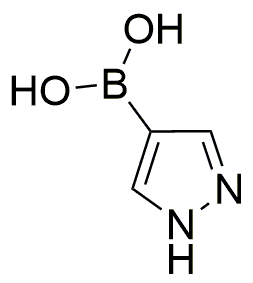1H-Pyrazole-4-boronic acid is widely utilized in research focused on:
- Drug Development: This compound serves as a crucial building block in the synthesis of pharmaceuticals, particularly in the development of anti-cancer agents and other therapeutic drugs.
- Chemical Synthesis: It acts as a versatile reagent in organic chemistry, facilitating cross-coupling reactions that are essential for creating complex molecules.
- Material Science: The compound is used in the formulation of advanced materials, including polymers and coatings, enhancing their properties such as durability and resistance to environmental factors.
- Agricultural Chemicals: It plays a role in the creation of agrochemicals, contributing to the development of effective herbicides and pesticides that improve crop yields.
- Bioconjugation: This chemical is utilized in bioconjugation processes, allowing for the attachment of biomolecules to surfaces or other molecules, which is essential in diagnostics and therapeutic applications.
General Information
Properties
Safety and Regulations
Applications
1H-Pyrazole-4-boronic acid is widely utilized in research focused on:
- Drug Development: This compound serves as a crucial building block in the synthesis of pharmaceuticals, particularly in the development of anti-cancer agents and other therapeutic drugs.
- Chemical Synthesis: It acts as a versatile reagent in organic chemistry, facilitating cross-coupling reactions that are essential for creating complex molecules.
- Material Science: The compound is used in the formulation of advanced materials, including polymers and coatings, enhancing their properties such as durability and resistance to environmental factors.
- Agricultural Chemicals: It plays a role in the creation of agrochemicals, contributing to the development of effective herbicides and pesticides that improve crop yields.
- Bioconjugation: This chemical is utilized in bioconjugation processes, allowing for the attachment of biomolecules to surfaces or other molecules, which is essential in diagnostics and therapeutic applications.
Documents
Safety Data Sheets (SDS)
The SDS provides comprehensive safety information on handling, storage, and disposal of the product.
Product Specification (PS)
The PS provides a comprehensive breakdown of the product’s properties, including chemical composition, physical state, purity, and storage requirements. It also details acceptable quality ranges and the product's intended applications.
Certificates of Analysis (COA)
Search for Certificates of Analysis (COA) by entering the products Lot Number. Lot and Batch Numbers can be found on a product’s label following the words ‘Lot’ or ‘Batch’.
Numéro de catalogue
Numéro de lot/série
Certificates Of Origin (COO)
This COO confirms the country where the product was manufactured, and also details the materials and components used in it and whether it is derived from natural, synthetic, or other specific sources. This certificate may be required for customs, trade, and regulatory compliance.
Numéro de catalogue
Numéro de lot/série
Safety Data Sheets (SDS)
The SDS provides comprehensive safety information on handling, storage, and disposal of the product.
DownloadProduct Specification (PS)
The PS provides a comprehensive breakdown of the product’s properties, including chemical composition, physical state, purity, and storage requirements. It also details acceptable quality ranges and the product's intended applications.
DownloadCertificates of Analysis (COA)
Search for Certificates of Analysis (COA) by entering the products Lot Number. Lot and Batch Numbers can be found on a product’s label following the words ‘Lot’ or ‘Batch’.
Numéro de catalogue
Numéro de lot/série
Certificates Of Origin (COO)
This COO confirms the country where the product was manufactured, and also details the materials and components used in it and whether it is derived from natural, synthetic, or other specific sources. This certificate may be required for customs, trade, and regulatory compliance.


